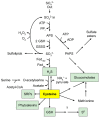Photorespiration: The Futile Cycle?
- PMID: 34062784
- PMCID: PMC8147352
- DOI: 10.3390/plants10050908
Photorespiration: The Futile Cycle?
Abstract
Photorespiration, or C2 photosynthesis, is generally considered a futile cycle that potentially decreases photosynthetic carbon fixation by more than 25%. Nonetheless, many essential processes, such as nitrogen assimilation, C1 metabolism, and sulfur assimilation, depend on photorespiration. Most studies of photosynthetic and photorespiratory reactions are conducted with magnesium as the sole metal cofactor despite many of the enzymes involved in these reactions readily associating with manganese. Indeed, when manganese is present, the energy efficiency of these reactions may improve. This review summarizes some commonly used methods to quantify photorespiration, outlines the influence of metal cofactors on photorespiratory enzymes, and discusses why photorespiration may not be as wasteful as previously believed.
Keywords: atmospheric CO2; climate change; crop yield; kinetics; metabolic interactions; metal cofactor; oxygenation; photorespiration; photosynthesis.
Conflict of interest statement
The authors declare no conflict of interest.
Figures






References
-
- Zelitch I. Photorespiration: Studies with Whole Tissues. Photosynthesis II. 1979;28:353–354.
-
- Canvin D.T. Photorespiration: Comparison Between C3 and C4 Plants. Photosynthesis II. 1979;29:368–396.
-
- Husic D.W., Husic H.D., Tolbert N.E., Black C.C. The oxidative photosynthetic carbon cycle or C2 cycle. Crit. Rev. Plant Sci. 1987;5:45–99. doi: 10.1080/07352688709382234. - DOI
-
- Sharkey T.D. Estimating the rate of photorespiration in leaves. Physiol. Plant. 1988;73:147–152. doi: 10.1111/j.1399-3054.1988.tb09205.x. - DOI
-
- Ogren W.L. Photorespiration: Pathways, Regulation, and Modification. Annu. Rev. Plant Physiol. 1984;35:415–442. doi: 10.1146/annurev.pp.35.060184.002215. - DOI
Publication types
Grants and funding
LinkOut - more resources
Full Text Sources
Miscellaneous

